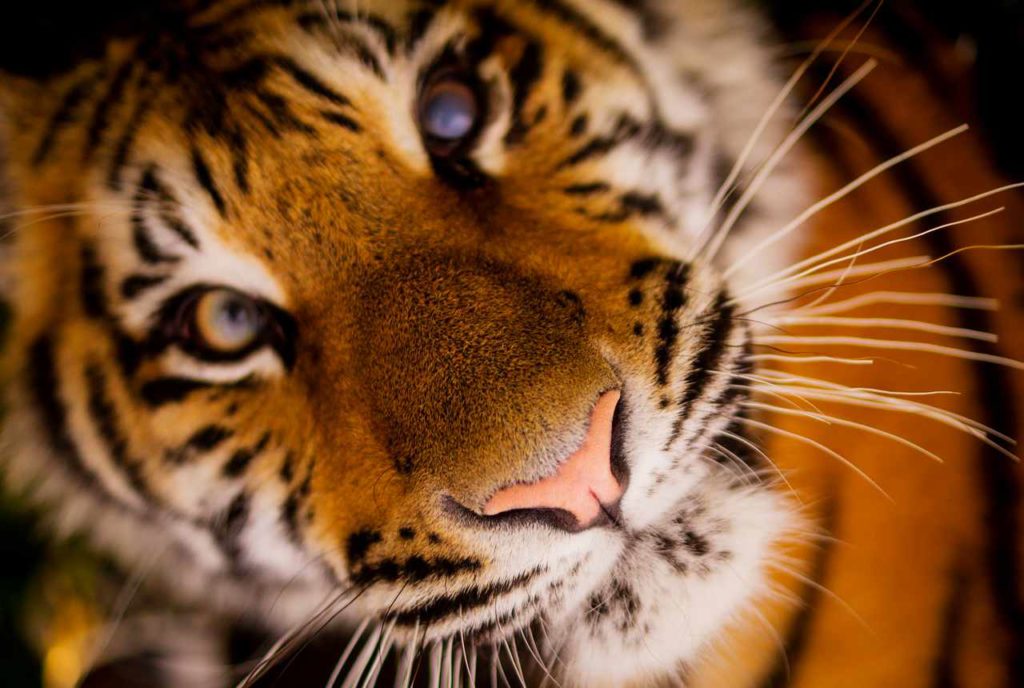
Tigers are the largest representatives of the cat family. Right after the white and brown bears, it is the largest land predator. All about tigers in one place. The tiger is the largest currently living species of wild cat of the genus Panthera
This one of the largest land predators is an agile, well-jumping and great swimming, solo hunting individual. It has always been awe-inspiring and fascinating at the same time. He has become a common symbol in the culture and mythology of the Far East. Usually it means militancy and courage, beauty, and immortality, but also bloodthirsty, greed and anger. But most of all, they are majestic animals. Large cats, such a predators, but walking with such grace. And believe me, that it orange striped fur, give them an additional charm.
Where do the tigers live?
Formerly their population was widely distributed on the Asian continent. Currently, they only live in southern and eastern Asia. Over the last century, tigers have lost more than 90% of their former range. They prefer to stay in lush and tropical forests.
What do tigers eat?
Tigers are carnivores. They are located on the highest level of the ecological pyramid. Virtually any animal, regardless of its size, can fall prey to it. They prefer to hunt large mammals – wild pigs, buffaloes, or roe deer. They will also not deny themselves a young elephant or rhino. They also kill the crocodile from time to time. They consume 20 to 35 kilograms of meat at a time. A hungry individual can eat up to 50 kilograms.
Tiger population…
Currently, only 4,000 individuals live in the world.
Length of life…
They live in captivity for up to 18 years.
The largest tiger in the world
The largest individual in the wild weighed 384 kg. In captivity, a specimen weighing 465 kg is known.
The most famous one …!
If you are thinking the same as me, then you are right. yes! The one and only Tigger , a jumpy friend from Winnie the Pooh stories. Beloved by so many ( kids and adults, me included), always happy, always ready to play.
**INTERESTING & FUN FACTS**
- Contrary to popular belief, tigers do not exist in Africa. In the wild, they can only be seen in Asia.
- The only danger for them is rhinoceros and elephants. It is they who are able to survive the clash with the tiger.
- Tigers hunt hidden. They have exceptionally good eyesight and hearing. They move extremely quietly thanks to the ability to hide claws. He waits for his victim in the thickets. When she feels that the time is right, she jumps out of the brush and tries to knock her victim down with her front paws. On average, 1 in approximately 15 attempts is successful. A larger victim will last for several days. They go hunting regardless of the time of day. This can happen during the day as well as at night.
- There have been cases of attacks on people. They do not see us as food and only attack us when we are in danger.
- Males occupy a territory ranging from 60 to 100 km². Females need up to 20 km². The less food there is in an area, the more food they need. They mark it by urinating and excrement.
- The female reaches sexual maturity between the ages of 3 and 4. In males, it happens a year later. Gestation lasts on average 93 to 114 days (termination usually takes 105 days). About 3-4 individuals are born in one litter.
- After birth, the cubs are blind and helpless. They weigh about 1 kilogram. In the first year of life, an average of 30% of specimens die.
- Females are only 4-5 fertile days a year.
- Scientists distinguished several subspecies of tigers. Currently, only 6 of them are alive.
- Tigers are in danger of extinction. The most endangered species is the Chinese tiger. Most likely, he cannot be met in the wild. 60 individuals live in Chinese centers. The most numerous is the Bengal tiger living in India, Nepal, Bangladesh, and Myanmar (about 2000 representatives).
- Siberian tigers attack bears from time to time. Anyone can win such a clash.
- An adult individual is able to accelerate to 65 km / h.
- What does a tiger look like? The adult specimen at the withers grows from 70 to 120 cm. The male’s body length ranges from 2.5 to 3.9 m and weighs from 90 to 310 kg. The female’s body is 2 to 2.8 m long and weighs 65 to 170 kg.
- Tigers are in danger of extinction. Man contributes to the deterioration of the situation through illegal hunting and deforestation.
- Tiger fangs are over 2 inch long (7 centimeters) in length.
- Tigers use their tails to communicate with each other. A tiger is relaxed if its tail hangs loosely. Aggression is manifested by shifting the tail sharply from side to side or by keeping it low with occasional intense twitching.
- The tiger generally hunts alone, capable of catching prey such as deer and antelopes. Unlike lions, tigers live alone and mark their territories to keep others away.
- The Latin name of the tiger is Panthera Tigris. The word Panthera comes from the Greek word for “hunter”, while tiger is an Old Persian word meaning “swift” or “arrow-like”.
- Scientists believe that the white spots behind the tiger’s ears help tigers follow their mothers through the dark forest.
- The Siberian tiger has fewer stripes than the Bengal tiger, and its stripes are brown rather than black.
- The big cat weighs 79.26 lb. (36 kilograms).
- Tigers hunt for their food but are also attacked by humans for their valuable fur and body parts. They believe that there are only 3,500 tigers left in the world. This makes them an endangered species.
- Almost as many tigers live in zoos and wildlife parks as there are in the wild.
- Tigers wait until dark to hunt. Due to the adaptation of the retina to reflect light back, tiger night vision is six times better than human vision. Tigers have more stamens in their eyes that are responsible for visual acuity in shapes than are cones, responsible for seeing colors, and which support their night vision.
- The Sumatran tiger is the smallest tiger. The male weighs about 120 kg, which is about the same as a female lion.
- A tiger in a zoo can live up to 20 years. Wild tigers live 10 to 15 years in the wild.
- A tiger’s night vision is 6 times better than that of a human.
- Tigers are carnivores. They are quiet, patient hunters with large, powerful paws and teeth to help them catch and eat their prey. Some of their favorite foods are pigs, deer, rhinoceros and even baby elephants.
- 100,000 wild tigers roamed Asia a hundred years ago.
- Less than 10% of tiger hunts are successful. When a tiger spots its prey, it sneaks as close to its prey as possible. The tiger then lunges at the animal, usually pushing it to tip over with its teeth and claws.
- Despite conservation efforts, the Siberian tiger may become extinct in the wild within the next ten years.
- A fully developed tiger can jump over an 8-meter obstacle.
- Identifying a tiger in a zoo is easy. But in their natural habitat, in scattered little areas in Asia, tigers are really hard to find. That is because their unique orange, black and white stripe pattern helps them blend in with the forests and grassy areas where they live and hunt.
- It may take several days for the tiger to finish eating its prey. It is known that tigers eat up to 28 kg of meat in one night, but more often they eat around 5 kg in one meal.
- Tigers not only have striped fur, but also striped skin.
- The tiger’s tongue is so rough that it can scrape flesh off its prey.
- The fastest specimens accelerate to 65 km / h.
- Has perfect eyesight. In the dark, he can see five times better than a human.
- He is the second record holder after the puma in the high jump and the second after the lion in the long jump. It can jump up to 5 m and cover a distance of 8-9 m in one jump.
- With one stroke of its paw, it can kill an animal the size of a large dog or even a human. Tigers can attack humans. However, these attacks are not intentional. A tiger will attack when a human enters its territory or when the animal is weakened, injured. Since it cannot count on any help, the herd is looking for easy prey. However, there are cases when a person becomes a “delicacy” for a tiger. There is a famous example of the Champawat Tigress who killed over 400 people.
- The tigers’ best developed sense is hearing. They pick up sounds with a frequency of 200 Hz to 100 kHz (five times higher than that heard by humans).
- The sense of smell is not highly developed. It is weaker than that of dogs.
- Tigers, like lions, open their mouths and stick their tongues out to facilitate air access to the olfactory receptors.
- The roar of a tiger is so loud that it can be heard from a distance of more than 3 km. In fact, the range of the roar is much greater because tigers can make sounds (infrasound) at an even lower frequency than that heard by humans.
- Tigers, like all cats, have a shutter shutter called the third eyelid.
- They are great swimmers and can kill a victim while swimming. They can cross a river 6-8 km wide and even about 30 km with the current.
- Tigers have small, round pupils and yellow irises. The retina of a tiger’s eye has six times more points (called rods) than humans responsible for night vision (scotopic). The rods receive information about the brightness of a given object, not about the color. The increased number of stamens allows them to see the movements of objects and animals in almost complete darkness. This gives them a huge advantage in the dark and therefore they hunt at night.
- The color of tigers depends on the season and the subspecies. The color of tigers varies from yellow to red orange with distinct black stripes. The belly and sides of the tiger’s head are white.
- Tiger hair also functions as a sense of touch. Sensory hair is spread over the entire skin, and whiskers are found on the eyebrows, cheeks, upper lip and on both sides of the mouth.
- The tiger stripes are like fingerprints. There are no two individuals with the same color. Brown Siberian tigers have the brightest stripes. There are also stripes on the skin.
- Tigers have many color variations. There are white, black, and blue tigers. The blue tiger is called the Maltese tiger and is probably a variation of the Bengal tiger. All white tigers found in zoos are descended from one father named Mohman. These tigers have more health problems such as cleft lip and palate, scoliosis, and strabismus. This is the result of inbreeding that provides zoos with white cats.
- In nature, the gene for white hair is found in one in ten thousand individuals.
- Most tigers live in tropical forests, in areas covered with grasses, reeds and bamboo.
- Its distinctive coloration helps the tiger to blend in with its surroundings.
- The most agile individuals are able to jump up to five meters. It can easily get the victim from the tree.
- In one jump, it can cover up to 10 meters in length.
- Unlike cats, they do not avoid water and swim very well.
- They have 30 teeth. Their tusks are about 7.5 cm long.
- The roar of the tiger can be heard from a distance of 3 km.
- The longest-lived tiger was 26 years old.
- They usually go hunting in the morning and in the evening. And it is for this reason that they have round pupils – unlike domestic cats.
- Like human fingerprints, tigers have unique stripes on their body. They can be helpful in identifying a specific individual.
- Tigers are loners. They do not form herds and prefer a solitary life.
- The vast majority of individuals have yellow eyes.
- He is the second record holder after the puma in the high jump and the second after the lion in the long jump. It can jump to a height of 5 m and cover a distance of 8-9 m in one jump.
- With one stroke of its paw, it can kill an animal the size of a large dog or even a human. Tigers can attack humans. However, these attacks are not intentional. A tiger will attack when a human enters its territory or when the animal is weakened, injured. Since it cannot count on any help, the herd is looking for easy prey. However, there are cases when a person becomes a “delicacy” for a tiger. There is a famous example of the Champawat Tigress who killed over 400 people.
- Over the past 80 years, three tiger subspecies have become extinct.
- It is estimated that between 1800 and 2009, tigers killed approximately 373,000 people.
- The stripes are not only on the fur, but also on the animal’s skin.
- A hundred years ago there were over 100,000 wild tigers in Asia.
- The national animal of India is the Bengal tiger.
- A dead male’s body sells for $ 10,000 on the black market.
- Tigers are unforgiving and tend to take revenge on those who have hurt them.
- Tigers are the largest cat species in the world, reaching up to 3.3 meters in length and weighing up to 330 kilograms! Find out about fascinating tigers and information about tigers.
- There are six distinctive tigers: Bengal, Siberian, Indochinese, Siberian, Chinese, and Malay. The extinct subspecies include the Caspian, Balinese, Javanese, and Trinil tigers that died out 1.2 million years ago.
- Tigers are easily recognizable by their dark vertical stripes and red-orange fur.
- At full speed, tigers can reach up to 65 km / h.
- Tigers hide their claws, which makes them silent hunters.
- Tigers have antiseptic saliva. After an injury, what they do is lick the area to prevent infection.
- The most common tiger is the Bengal tiger.
- The stripes the tiger has are as unique as human fingerprints.
- They rarely climb trees. They rest in the shade under trees and in the Siberian steppes in rock clefts.
- Tigers hunt all animals of all sizes. Only adult, healthy rhinos and elephants can resist their voracity. In a clash with a brown bear, a bear is often defeated.
- One time, a tiger eats 44 – 77 lb. (20-35 kilograms) of meat. Hungry can eat up to 110 lb. (50 kilograms). They can hide some uneaten meat for the next meal.
- Tigers can run at a speed of 60 km / h.
- Males cover an area of 60-100 km2, females up to 20 km2. Territories are marked with urine, feces, and glandular odors.
- The basic family unit is the female with the young. Males only hang out with them occasionally.
- Tigers only walk in the company of relatives. In the case of females, it is mother and daughter.
- Females reach sexual maturity between 3-4 years of age, males a year later. Gestation lasts 104-106 days on average, 3-4 cubs are born.
- Tigers live 10-15 years.
- In the wild, tigers live only in Asia. One hundred years ago, there were over 100,000 of them, now about 4,000.
- Tigers can mix with other cats. The descendant of the lion and the tigress is the Tigris, and the tiger and the lioness are the crucible.
- The tiger’s greatest enemy is man and Asian folk medicine. The tiger’s body parts are used in folk medicine as Tigers are a symbol of the Far East culture.
- White tigers are especially venerated, in China they are the kings of animals, in Buddhism – a symbol of hospitality and piety, in Japan – one of the four good spirits.
- The tiger is one of the most popular mascots of sports teams.
- International Tiger Day falls on July 29.
- Today, more than 3,000 wild tigers roam forests and savannas.
- One swipe of the Tiger’s forearm is enough to kill a human or an animal, or at least break bones.
- Sheer Khan was a mortal tiger in The Jungle Book by Rudyard Kipling (1894).
- The tiger’s hind legs are longer than the front legs, which makes it a nice running / jumping machine.
- A tiger can kill instantly with a single bite to the neck stabbing through the spinal cord. A tiger can also strangle its prey by pinching its throat for up to 10 minutes.
- Unlike most members of the cat family, they like water and often cool down in ponds or streams.
- Tigers are nocturnal animals. It is not necessarily true that all Tigers are nocturnal, but yes, they prefer to engage in most of their hunting activities at night. Tigers prefer to avoid conflicts during the day and also patrol their territory at night.
- Tigers live in the wild for 20-26 years.
- Adult tigers generally live alone.
- The roar of a tiger can be heard up to three kilometers away.
- Unlike most other cats, tigers are great swimmers and actually like water.
- Tigers feast on many animals, depending on their territory. These include: antelope, wild boar, buffalo, camel, fish, and horse.
- Young tigers are born blind and only half of them survive. The cubs see nothing, they only follow the scent of their mother. Since they are born blind and cannot keep up with their mothers, most of them die of hunger or cold.
- Tigers have more than 100 stripes, which helps the tiger blend in with long grass.
- Tigers have killed more people than lions or leopards. In the 19th century, tigers could kill up to hundreds of thousands of people.
- In Asian folklore, the tiger is seen as a terrifying creature, replacing the werewolf.
- Cubs are born blind and open their eyes 1-2 weeks after birth.
- The young start learning to hunt at the age of six months but stay with their mothers until they are 18 months old.
- Interestingly, a tiger can live two weeks without food.
- They can eat over 65 lb. (32 kilograms) of meat in one meal.
- Tigers are carnivores, they only eat meat.
- Interestingly, the smell emitted from the urine of the Tigers smells like buttery popcorn.
- Tigers can mate with other big cats. If a male Tiger is mated with a female Lion, the hybrid animal is known as the Crucible.
- Less than 100 years ago, tigers were found all over Asia. Unfortunately, hunting and habitat loss have threatened the population and now their range has been reduced to about 7% of their former size.
- Tigers are one of the Chinese zodiac signs.
- Tigers communicate through scent markings, visual cues, and a variety of sounds such as roaring, growling, moaning, and hissing.
- Crossbreeding of tigers is prohibited in Taiwan.
- While a tiger is a great hunter, only one in every 20 hunts ends up killing its prey. In areas with fewer prey, even fewer hunts succeed.
- Tigers can imitate the cry of other animals. The tigers emit a “pook” that resembles the sound of a sambar that drags these innocent animals into an ambush.
- The tiger’s method of killing its prey is to stalk them before being ambushed and incapacitated, before biting.
- The Bengal tiger is the national animal of Bangladesh and India.
- Human behavior can make a tiger feel threatened and attack people.
- Tigers are solitary hunters and generally seek food alone at night.
- While tigers sometimes congregate, they usually live alone.
- A Siberian tiger has approximately 3,000 hairs on one square centimeter of skin.
- Tigers can be found in at least nine countries, which include the US, Czech Republic, China, Iran, Russia, India, UAE, and Argentina.
- Fossilized tiger remains found in parts of China are believed to be 2 million years old.






































thanks for sharing this article about tigers..
my pleasure . I am happy you like it 🙂
Thanks for sharing excellent informations. Your site is so cool. I am impressed by the details that you have on this web site. It reveals how nicely you perceive this subject. Bookmarked this website page, will come back for more articles. You, my pal, ROCK! I found simply the info I already searched everywhere and simply couldn’t come across. What an ideal web-site.
Thank you for another informative website. Where else may just I get that kind of information written in such an ideal means? I’ve a mission that I’m simply now running on, and I have been on the glance out for such info.
I am extremely inspired with your writing abilities as well as with the format in your weblog. Is that this a paid topic or did you modify it your self? Anyway keep up the nice high quality writing, it抯 uncommon to peer a great blog like this one today..
I wish to voice my respect for your kindness for individuals who require help on this particular issue. Your special dedication to getting the solution across had become particularly helpful and has in every case allowed folks just like me to realize their goals. Your personal important guidelines signifies much a person like me and additionally to my colleagues. Regards; from all of us.
Thanks for sharing . Keep it bro
Interesting blog! Is your theme custom made or did you download it from somewhere? A theme like yours with a few simple adjustements would really make my blog jump out. Please let me know where you got your theme. Thanks a lot